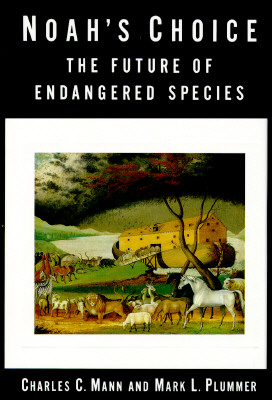

| NOAH'S CHOICE The Future of Endangered Species Charles C. Mann Mark L. Plummer New York: Alfred A. Knopf, 1995 |
Rating: 5.0 High |
|||
| ISBN-13 978-0-679-42002-6 | ||||
| ISBN 0-679-42002-9 | 302pp. | HC | $24.00 | |
The future of endangered species will, by definition, always be in doubt. If this were not so, they would not be listed as endangered. Of course, any given species can have an uncertain future without being declared endangered.1 Recognition of this fact led to the creation of the Endangered Species Act.2 It is one of the more hopeful signs of recent years.
However, there is always a tradeoff involved: Are the measures needed to preserve species x justified in economic terms? Simply put, is it worth the trouble? Written by a science writer (Mann) and a former Federal Trade Commission economist who now is a Senior Fellow of the Discovery Institute (Plummer),3 this book seems to take the position that it seldom is.
"Some 2,450 counties—almost 90 percent of the continental United States—are home to one or more species on the official endangered list, which most biologists believe is incomplete. Unlike Latimer County, those counties tend to contain large numbers of people. As a result, some 210 million Americans live close to at least one listed species, a number that will grow as the list grows.4 Indiana has the Indiana bat; Arizona, the Arizona hedgehog cactus; Florida, the Florida grasshopper sparrow; Oregon, the Oregon silverspot butterfly; Virginia, the Virginia round-leaf birch; Alabama, the Alabama cavefish. Each is on the list, and all are menaced by habitat transformation." Their plight will not be easily resolved. Habitat transformation is not simply a matter of human greed and stupidity. People use land for many reasons—most unexceptional, many praiseworthy. The homes we live in, the buildings we work in, the churches we worship in, the schools we learn in, the libraries, art museums, movie theaters and concert halls we experience art in—all are built on land that once housed other creatures. As a consequence, conflicts between humans and other species are inescapable, because they stem from our deepest aspirations. – Pages 14-15 |
A faction in this dispute holds the default position that preserving species is never justified. Sometimes that turns out to be the correct position. But it should never be the position going in; it should only be taken after deliberation over all the relevant facts. The reason we are facing environmental problems on so many fronts is that the default assumption of human dominion held for so long.
That said, it is fair to consider that the Endangered Species Act in its present form is endangered. Because it sets a standard that in most cases will be impossible to meet, it will in most cases be ignored or circumvented.6
It would be wrong to conclude from this that the authors are hostile to species preservation. They simply reckon that preserving a species can seldom be assured without enormous cost, and that it is all too easy to pass well-intentioned laws that impose preservation as a duty while providing no funding to enable that duty to be carried out. This — largely because of inattention in Congress — is exactly what the 1973 revision of the Endangered Species Act became.
The authors document numerous cases in which the inflexible requirements of the 1973 ESA butted up against communities unwilling to shoulder the considerable costs of compliance.5 The result was that protection plans, no matter how carefully designed and extensively negotiated, were never carried out. (Tellico Dam was the exception; after years of legal wrangling, the snail darter was protected when the dam was halted at 99 percent completion. Ironically, the snail darter would have survived either way; it was more widespread than biologists knew at the time.)
Perhaps the most wrenching failure was the collapse of the valiant attempt to develop a regional protection plan for Austin, Texas.
"The habitat-conservation planning process failed to work as Babbitt had advertised it would, and not for a lack of effort or money. The federal government has focused its efforts away from the city, where land is cheaper. Developers are funding much of the effort to preserve some vireo habitat, but nobody has indicated a willingness to fill the gap left by the failure of the county's bonds. And yet the birds must be saved— the Endangered Species Act will not be satisfied with anything less. And the same thing must be repeated many times in many other places: all biodiversity must be saved, yet all biodiversity cannot be saved; human interests are not to be respected, yet human interests will always be respected. clinging to the Noah Principle is an example of what Mark Sagoff dryly called the attempt "to cast social and environmental policy in the optative mood." The word optative is a grammatical term that means "wishful" or "dreamy." In our dream of perfection, Sagoff warned, "The perfect society to which we aspire in theory may become a powerful enemy of the good society we can become in fact."" – Pages 199-200 |
The aim of the authors is to show the counterproductiveness of the ESA as it now exists. In this, through careful research and clear writing, they succeed. Then they make some sensible recommendations, which boil down to: Build some provisions for compromise into the Act, and ease the burden on local communities by creating a biodiversity preservation trust fund.
The research is backed up by extensive endnotes and an excellent index. I judge that the authors have done a very competent job of making their case, and so I rate this book a must read.

 To contact Chris Winter, send email to this address.
To contact Chris Winter, send email to this address.